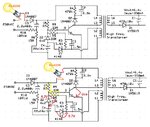jayaramc
Newbie level 6
I have a lamp charger using 13001 which is similar to mobile charger and dead recently. I have changed the faulty components 13001 8AV and 8v2 Zener and no other components found to be faulty.
Few detail for your analysis.
Collector to Emitter voltage is 300v. Base to Emitter voltage is 8.2v. The voltage at C4 is 0.5v. All the diodes/resistor/cap and transformer coils are good as well.
I am worried why the transistor is not switching although it has a base voltage of 8v. There is no feedback voltage and secondary output.
I have uploaded a similar circuit.
Kindly help me to get this circuit working.
Few detail for your analysis.
Collector to Emitter voltage is 300v. Base to Emitter voltage is 8.2v. The voltage at C4 is 0.5v. All the diodes/resistor/cap and transformer coils are good as well.
I am worried why the transistor is not switching although it has a base voltage of 8v. There is no feedback voltage and secondary output.
I have uploaded a similar circuit.
Kindly help me to get this circuit working.

